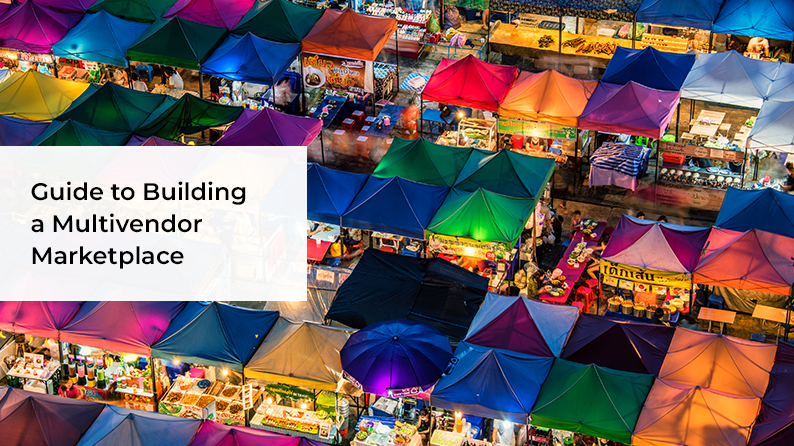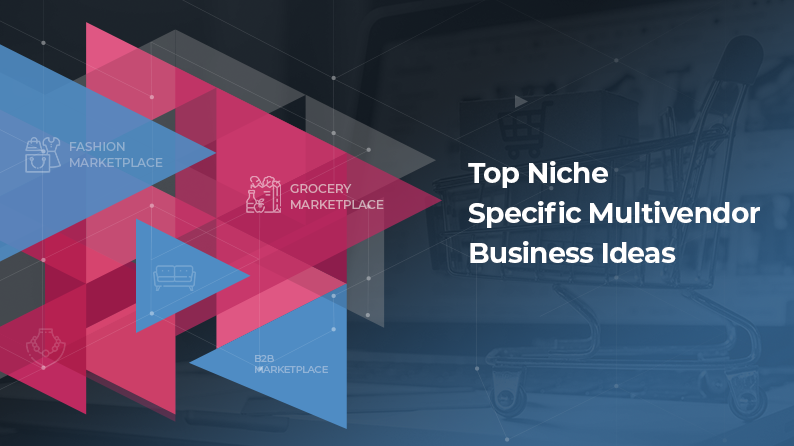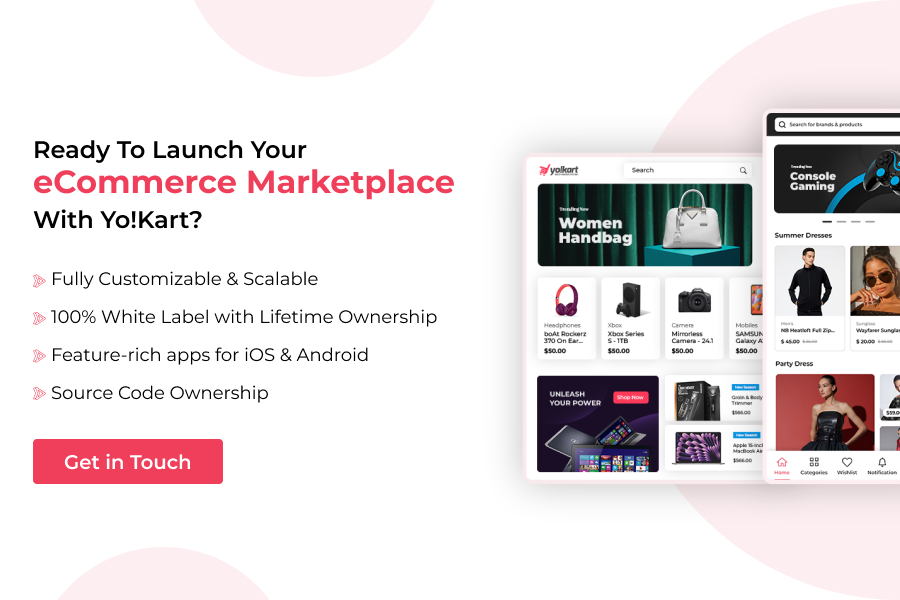Published on 14th May, 2025
In this ever-evolving digital economy, the rules of traditional commerce are being rewritten—and digital platforms are coming out on top. As consumers demand more variety, faster fulfillment, and richer shopping experiences, multivendor marketplaces have become the gold standard for scalable, customer-centric commerce.
According to Statista, the global eCommerce market is expected to surpass $5.89 trillion by 2029. And, sales through multivendor marketplaces alone are projected to reach $8.7 trillion by 2025. From global giants like Amazon and Walmart to niche leaders such as Etsy and eBay, multivendor platforms are setting new standards in scalability, customer experience, and vendor empowerment.
Thus, with more businesses recognizing the long-term value of shared infrastructure, diversified product offerings, and lower inventory risks, multivendor marketplace development is becoming a strategic priority for startups and enterprises alike.
Therefore, this guide breaks down the entire multivendor marketplace development process—from foundational planning and monetization strategy to feature integration and launch to help businesses build a scalable multivendor marketplace.
Table of Contents
- What is a Multivendor Marketplace?
- Types of Multivendor Marketplaces
- Popular Multivendor Marketplaces
- Why Multivendor Marketplaces Are the Future of Online Business?
- Why Invest in Multivendor Marketplace Development?
- Key Features of a Successful Multivendor Marketplace
- Key Steps for Successful Multivendor Marketplace Development
- Multivendor Marketplace Development: Build from Scratch vs. Buy a Readymade Solution
- Factors Affecting the Cost of Multivendor Marketplace Development
- Yo!Kart Multivendor Marketplace Software: The Most Reliable Tech Partner
- Wrapping Up
- FAQs
What is a Multivendor Marketplace?
A multivendor marketplace is a digital platform that enables multiple independent sellers to list and sell their products or services under a single digital storefront. Unlike a single-vendor store, where only one brand or business offers goods, a multivendor marketplace functions more like a virtual shopping mall, housing a variety of sellers under one roof. Therefore, this model facilitates a broader, more diverse catalog by aggregating offerings from various merchants, all managed within one centralized system.
At its core, multivendor marketplaces are built to facilitate seamless interaction between three key stakeholders: the platform owner (admin), the vendors, and the end customers. The marketplace owner is responsible for the overall infrastructure, user experience, compliance, and monetization strategy, while individual vendors manage their own catalogs, pricing, inventory, and fulfillment operations.
Here’s how a multivendor marketplace works:
1. Sellers sign up on the marketplace, create their individual stores, and list products or services with relevant details.
2. Customers visit the marketplace, browse products from various vendors, and make purchases, often adding products from multiple sellers into one cart.
3. Once the order is placed, the system automatically splits the order based on vendor involvement, notifying each seller to fulfill their respective portion.
4. The marketplace collects the payment, takes a commission, and transfers the rest to the vendors, often using automated split-payment systems.
5. Upon receiving the product, buyers can rate both products and vendors, contributing to marketplace transparency and credibility.
6. The marketplace owner/admin oversees the platform, handles disputes, ensures policy compliance, and manages monetization strategies.
Types of Multivendor Marketplaces
Multivendor marketplaces are broadly categorized based on the nature of products or services they offer, the target audience, and the business model. Understanding these classifications is essential for entrepreneurs and enterprises seeking a strategic edge in multivendor marketplace development.
1. Based on Offerings
- Product-based Marketplace: These platforms allow vendors to list and sell physical goods. Customers can compare offerings from different vendors and make informed purchasing decisions.
Example: Amazon, eBay, Etsy
- Service-based Marketplace: These marketplaces connect service providers with customers. Vendors offer services instead of physical products, and the platform facilitates discovery, booking, and payment.
Example: Upwork, Thumbtack, Fiverr
- Hybrid Marketplace: Combines both product and service offerings, allowing users to purchase goods and book services within a unified ecosystem, enhancing convenience and cross-selling opportunities.
Example: Urban Company, TaskRabbit
2. Based on the Target Audience
- Business-to-Business (B2B) Marketplace: Facilitates transactions between businesses, typically involving bulk orders, procurement processes, or supply-chain integrations tailored for enterprise needs.
Example: Alibaba, ThomasNet, Faire
- Business-to-Consumer (B2C) Marketplace: Enables businesses to sell directly to consumers, offering a scalable retail channel with tools for customer engagement, fulfillment, and support.
Example: Walmart, ASOS, Amazon
- Consumer-to-Consumer (C2C) Marketplace: Empowers individuals to trade goods or services directly with other consumers, leveraging peer-to-peer models supported by platform-mediated trust, ratings, and payment systems.
Example: eBay, Poshmark
3. Based on Business Model
- Horizontal Marketplace: Offers a broad spectrum of categories across multiple industries, prioritizing scale, customer reach, and product diversity to attract a wide, general audience.
Example: Amazon, Flipkart, AliExpress
- Vertical Marketplace: Specializes in a single niche or industry, delivering deep expertise, tailored solutions, and curated offerings that enhance value for a specific customer segment.
Example: StockX, GNC, Bath & Body Works
Launch a Multivendor Marketplace that Caters to Diverse Business Models
Popular Multivendor Marketplaces
The influence of multivendor marketplaces is increasingly shaping the global eCommerce landscape. These digital ecosystems have proven to be resilient, scalable, and highly lucrative—capturing both consumer trust and investor confidence. Thus, understanding the trust of leading multivendor marketplaces can provide valuable insights into the operational dynamics and business models that drive this domain.
Here’s a list of popular multivendor marketplaces in the world:
| Platform | Founded In | Business Model | Annual Revenue |
| Amazon | 1994 | Multivendor eCommerce | $646.34 billion |
| Alibaba | 1999 | Multivendor eCommerce | $134.4 billion |
| Walmart | 2009 | Omnichannel Retail | $70.141 billion |
| Mercado Libre | 1999 | Online Retail Marketplace | $20.5 billion |
| Wayfair | 2002 | Furniture Retail | $11.9 billion |
| Zalando | 2008 | Fashion eCommerce | $11.22 billion |
| eBay | 1995 | Online Auction Marketplace | $10.16 billion |
| ASOS | 2000 | Fashion Marketplace | $3.87 billion |
| Etsy | 2005 | Handicrafts Marketplace | $2.8 billion |
| Newegg | 2001 | Electronics eCommerce | $1.65 billion |
Why Multivendor Marketplaces Are the Future of Online Business?
Multivendor marketplaces have emerged as transformative platforms that create value for every stakeholder involved, making it a uniquely sustainable and profitable business ecosystem. Therefore, this section explores how each stakeholder benefits, making the case for why this model has become the gold standard for modern eCommerce.
Advantages for Buyers in a Multivendor Marketplace
- Wider Product Selection: Multivendor marketplaces aggregate offerings from numerous sellers, allowing buyers to access a vast range of products from numerous brands in one place. This diversity significantly enhances customer choice and convenience.
- Competitive Pricing & Offers: The presence of multiple sellers offering similar products naturally fosters competition, driving down prices and increasing promotional offers, discounts, and loyalty programs for buyers.
- Streamlined User Experience: From advanced search and filtering options to personalized recommendations and secure checkout processes, buyers benefit from a frictionless, user-centric experience that mirrors the expectations set by leading global platforms.
Opportunities for Sellers in a Multivendor Platform
- Instant Access to Wider Customer Base: Instead of investing heavily in traffic acquisition and digital infrastructure, sellers gain instant access to a large and often targeted customer base, reducing their go-to-market time and cost.
- Reduced Operational Overhead: With logistics, payments, and customer service often integrated within the platform, sellers can focus on product sourcing and fulfillment, while the platform handles the heavy lifting.
- Scalability and Growth Opportunities: As the platform scales, so does the exposure for the seller. Many marketplaces offer tiered seller programs, international shipping options, and tools for catalog expansion, enabling sellers to grow in parallel with the marketplace.
The Business Edge for Marketplace Owners
- Diverse Revenue Streams: Monetization avenues such as commissions per sale, subscription fees, featured listings, advertising space, and transaction charges provide a steady and scalable income model. This diversity ensures consistent revenue flow and long-term profitability.
- Low Inventory Risk: Unlike traditional eCommerce models, marketplace owners do not need to hold inventory. The platform merely facilitates transactions, minimizing operational risks and warehousing costs.
- Scalable Business Model: Multivendor marketplaces scale exponentially with each new vendor added. More vendor means more products, more buyers, and more transactions—all contributing to the platform’s growth without proportional operational burden.
Why Invest in Multivendor Marketplace Development?
In an era defined by digital acceleration and consumer convenience, multivendor marketplace development has emerged as a strategic growth lever for businesses seeking to capture a broad audience, drive scalable revenue, and foster ecosystem-led commerce. Here’s why investing in such a platform is not merely a technological upgrade, but a forward-thinking business decision that aligns with the trajectory of global commerce:
1. Intensifying Market Statistics
The global eCommerce landscape is undergoing a paradigm shift, with multivendor platforms at the forefront of this transformation. According to statistics, 62% of global e-commerce sales are made through online marketplaces, with multivendor platforms accounting for a significant share of this growth.
Industry giants like Amazon, Etsy, Alibaba, and Walmart Marketplace are testament to this scalable, high-yield model. Startups and enterprises alike are recognizing the immense value of enabling third-party sellers under one digital roof—diversifying offerings without incurring inventory risks.
2. Diverse and Sustainable Monetization Models
One of the most appealing aspects of a multivendor marketplace is the flexibility in revenue generation. Unlike traditional eCommerce stores, these platforms support multiple monetization streams, allowing for both short-term returns and long-term profitability. Some common models include:
- Commission-based Model: Earn a percentage from every transaction made by vendors—low risk, high scalability.
- Subscription Charges: Charge vendors for monthly or annual access to sell on the platform or offer exclusive benefits, ensuring predictable recurring revenue.
- Third-Party Advertising: Offering promotional opportunities to businesses by placing ads on the marketplace.
- Featured Listings: Empowering sellers to promote their stores or products on the marketplace to enhance visibility.
- Value-Added Services: Offering premium services that go beyond a product’s core functionality, such as offering premium features, one-day or same-day delivery, etc.
This diversification of income streams not only ensures financial viability from day one but also allows marketplace owners to refine monetization strategies as the platform evolves.
3. Long-Term Scalability
Multivendor marketplaces are inherently designed for scalable growth. Unlike traditional single-vendor eCommerce platforms, multivendor platforms allow vendors to manage their own inventory, enabling the platform to grow exponentially without direct operational burden on the marketplace owner. As new vendors join the platform, product diversity increases, which in turn enhances buyer engagement and retention.
Additionally, the modular nature of contemporary platforms allows businesses to iterate quickly, launch in new verticals, or localize their offerings for different markets—all while leveraging a unified backend.
4. Automated Operations
Modern multivendor marketplaces support automation at multiple levels—from inventory synchronization and order fulfillment to performance analytics and fraud detection. This automation significantly reduces operational overhead and empowers platform owners to focus on strategic expansion, ecosystem partnerships, and data-driven optimizations. Ultimately, automation transforms a multivendor marketplace from a manually intensive operation into a smart, self-optimizing ecosystem.
Create a Highly Professional, Profitable Multivendor Marketplace
Key Features of a Successful Multivendor Marketplace
A robust and scalable multivendor marketplace thrives on the seamless coordination of multiple stakeholders—buyers, sellers, and admins. The success of such a platform hinges on a carefully engineered feature set that prioritizes user experience, operational efficiency, and monetization potential.
Below are the must-have features that form the backbone of a high-performing multivendor marketplace:
1. Powerful Vendor Dashboard: A dedicated vendor dashboard is essential for enabling sellers to manage their eCommerce operations efficiently. Key functionalities should include product handling, inventory management, order & shipping status tracking, and sales analytics.
2. Intuitive Buyer Experience: Buyers expect a personalized and streamlined shopping experience. Therefore, it is essential to provide effortless navigation, personalized recommendations, and secure transactions on the platform.
3. Robust Admin Panel: The admin panel must offer complete control and transparency over the platform’s ecosystem and empower the marketplace owner to manage products, monitor transactions & commissions, configure platform rules, and other related actions.
4. Secure Payment Gateways: The payment processing system must be seamless, secure, and support multiple providers, including international transactions. It should offer split payments for vendors and admins, multiple payment methods, and ensure compliance with the latest security standards.
5. Order & Shipping Management: Seamless logistics are critical for customer satisfaction. Hence, the system should integrate with major shipping providers via APIs and support vendor-specific shipping rules by product and region.
6. Ratings & Reviews System: Trust-building mechanisms are vital for long-term sustainability. Thus, the system should include a robust review and feedback mechanism that allows buyers to rate products & sellers and showcase them on the seller’s storefront.
7. Marketing & SEO Tools: A thriving marketplace needs built-in growth enablers like SEO-optimized URLs and metadata for visibility, integrated email and SMS campaigns for engagement, and affiliate or referral systems to drive user acquisition through incentivized promotion.
8. Mobile Responsive: The marketplace should be fully responsive across all devices and screen sizes, ensuring a seamless user experience on mobile browsers. A Progressive Web App (PWA) approach is recommended to deliver app-like performance and accessibility without requiring a native app download.
9. Native Mobile App Support: To maximize user engagement and accessibility, native mobile apps for both Android and iOS can be developed. These apps should mirror the full functionality of the marketplace while leveraging device-native features to optimize performance, usability, and customer retention.
Key Steps for Successful Multivendor Marketplace Development
Building a multivendor marketplace is much more than just building a digital platform, it is about designing a resilient ecosystem that balances the needs of each stakeholder involved. The process demands strategic insights, technical excellence, and market alignment.
Here’s a comprehensive breakdown of the core steps involved in multivendor marketplace development from a business-first perspective:
Step 1: Market Research and Niche Selection
The foundation of any multivendor marketplace lies in a deep understanding of the market it tends to serve. This begins with comprehensive research to identify viable niches, evaluate customer needs, and analyze the strengths and weaknesses of competitors. Modern tools such as SEMrush, Google Trends, and industry reports from platforms like Statista, Grand View Research can provide valuable insights into demand patterns, emerging sectors, and regional gaps.
The objective here is to carve out a differentiated space that addresses an underserved audience or offers a unique value proposition. At this stage, businesses should also define core buyer personas and validate the potential for vendor participation.
A clear market-fit analysis sets the direction for product positioning, features, and growth strategies.
Step 2: Strategic Planning: Defining Business Model & Monetization Strategy
Once the market opportunity is defined, the next critical step is establishing a solid business framework. This includes:
- Defining your core value proposition: What unique experience will your multivendor marketplace offer to vendors and customers?
- Choose the revenue strategies: Evaluate commission-based, subscription-based, freemium, partnerships, and advertising revenue models. Consider hybrid combinations based on user behaviors.
- Define your operational workflows: Beyond revenue, operational workflows must be designed, covering everything from vendor onboarding and product moderation to transaction management and dispute resolution.
Establishing these systems early on prevents operational bottlenecks and results in a lean, scalable business model mapped with clear revenue logic and operational clarity.
Step 3: Choosing the Right Technology Stack
Choosing the right technology stack is pivotal to ensuring your marketplace is scalable, secure, and adaptable. At this stage, the focus should be on identifying solutions that can support seamless interactions between buyers and sellers, ensure fast load times, and provide secure transactions.
A good technology foundation enables easy integration with payment systems, logistics services, and third-party tools for analytics, marketing, and customer support. Besides, scalability is also crucial; your technology choices must accommodate platform growth without sacrificing speed or user experience.
Ultimately, the chosen stack must align with your business goals, technical expertise, and future plans for expansion, ensuring your multivendor marketplace remains competitive and adaptable as the market evolves.
Step 4: Designing UI/UX
User experience is the linchpin of any successful multivendor marketplace. Whether it’s the buyer browsing products or a vendor managing their store—every interaction should be intuitive, seamless, and visually appealing. This is because user experience directly impacts vendor retention, conversion rates, and transaction volumes.
What do you need to do:
- Design dedicated interfaces for buyers, sellers, and admins—each tailored to their unique needs and goals.
- Use design thinking methodology to map user journeys, eliminate friction points, and ensure mobile-first responsiveness.
- High-fidelity prototypes should be developed and validated before coding begins.
- Mobile responsiveness, accessibility compliance, and localized content are also essential, especially for platforms aiming at global or multi-regional audiences.
- Optimize search and filtering capabilities, personalized recommendations, and checkout flows.
As a result, you’ll get a frictionless, conversion-driven interface that balances the aesthetics and performance of a multivendor marketplace.
Deliver Rich User Experience with an Intuitive Multivendor Platform
Step 5: Agile Development: Front-end, Back-end, and Infrastructure
With the design finalized, development begins—ideally through an agile methodology. The platform should be built in incremental sprints, starting with the most critical components: the buyer interface (catalogs, filters, checkout), the vendor portal (product uploads, order management, performance metrics), and the admin panel (commission settings, content control, analytics).
Development teams should prioritize clean, scalable code that adheres to established coding standards and best practices. Modular architecture and component-based development should be embraced to facilitate easier maintenance and feature expansion in the future. Moreover, building in phases allows for faster market entry, early feedback, and iterative improvement based on real user data.
Step 6: Integrating Essential Features and Business APIs
A multivendor marketplace must operate as an interconnected ecosystem to operate efficiently. The platform should integrate essential features and integrations that ensure seamless operations and enhance user experience.
These integrations include:
- Secure payment gateways (e.g., Stripe, PayPal)
- Real-time inventory and order management systems
- Shipping and logistics APIs
- Tax calculation services
- Customer communication tools
- Analytics platforms for performance tracking
- Social media and marketing tools
Additionally, integrate essential eCommerce features such as advanced search & filtering, product reviews & ratings, multi-lingual & multi-currency support, wishlist or save for later features, seamless vendor onboarding, bulk order discounts, RFQs, and role-based access controls to ensure that your multivendor marketplace remains competitive.
By integrating these features and APIs, your multivendor marketplace will be equipped to handle complex operations while delivering a seamless experience for users. These tools collectively support scalability, compliance, automation, and data-driven decision-making.
Step 7: Testing and Quality Assurance
Before going live, your multivendor marketplace must undergo rigorous quality assurance testing. This includes functional testing to ensure all features work as intended, performance testing under simulated traffic loads, and compatibility testing across devices and browsers.
Security is paramount, especially when handling user data and payments. Implement best practices such as SSL encryption, secure login protocols, two-factor authentication, and regular penetration testing. Additionally, ensure that the platform complies with relevant regulations and security standards, such as GDPR, PCI-DSS, and data protection laws in your target regions.
Step 8: Launch and Optimize Based on User Feedback
The final stage is the launch, but it should not be seen as an endpoint—rather, it is the beginning of continuous evolution based on future trends and user feedback.
Start with a soft launch or beta release to a limited audience, collect feedback, and make necessary improvements. Simultaneously, roll out a well-defined go-to-market strategy involving digital marketing, influencer outreach, vendor partnerships, and SEO.
Post-launch, monitor key performance indicators such as conversion rates, customer acquisition costs, user activities, and cart abandonment. These metrics will guide future development cycles.
Continuous optimization—driven by user insights and market changes—is critical to sustaining growth, improving engagement, and maintaining a competitive edge in the long term.
Multivendor Marketplace Development: Build from Scratch vs. Buy a Readymade Solution
While embarking on multivendor marketplace development, one of the most strategic decisions a business must make is whether to build the platform from scratch or leverage a readymade (self-hosted or SaaS-based) software. While each approach has distinct advantages and considerations, making the right choice is highly dependent on your business model, scalability goals, budget, and timeline.
1. Custom Development
Custom development involves building a multivendor marketplace from the ground up, tailored to your specific business needs, user experience goals, and long-term vision. This approach gives you complete control over the architecture, features, user experience, and branding—ensuring complete flexibility.
Pros:
- Tailored precisely to your business logic, user flows, and branding requirements.
- Enables you to design the platform with scalability and performance in mind.
- Complete ownership of source code and infrastructure.
Cons:
- Building a platform from scratch requires a higher initial investment.
- Longer development cycles, often taking up to several months or even a year.
- Need to hire a dedicated technical team of developers, designers, and testers.
- Demands ongoing updates and maintenance to stay updated.
- Often includes risks of encountering any bugs, downtime errors, etc.
Best Suited For:
Large enterprises, businesses with highly specialized requirements, or those seeking to build a differentiated and scalable digital product.
2. Readymade Software
Readymade software solutions (like Yo!Kart, CS-Cart, or Sharetribe) are pre-built frameworks that can be customized to build a fully functional multivendor marketplace. These multivendor marketplace software equips all essential features, functionalities, and business APIs right from the outset, allowing you to launch your platform quickly and cost-efficiently.
Pros:
- Allows rapid deployment and faster time-to-market (as little as a few weeks).
- Comes equipped with core marketplace features and integrations.
- Already tested, eliminating the risks of coming across any bugs.
- Eliminate the need for a large in-house technical team.
- Enjoy flexibility in scalability, branding, and feature enhancements.
- Available on subscription or license-based model, making them a cost-effective solution.
Cons:
- SaaS solutions like CS-Cart or Sharetribe can become expensive over time due to ongoing subscription costs. Therefore, it is recommended to utilize on-premise solutions like Yo!Kart that offers a one-time license fee.
- SaaS solutions create dependency on the software provider for updates, features, and enhancements, while an on-premise solution like Yo!Kart grants greater control over the platform.
Best Suited For:
All types of businesses—be it startups, SMBs, large enterprises, or businesses looking to validate their marketplace idea.
Develop a Scalable Multivendor Marketplace with the Best-in-Class Software
Factors Affecting the Cost of Multivendor Marketplace Development
Developing a multivendor marketplace is a significant strategic investment, and the total cost can vary widely based on numerous factors. Among these, the development approach stands out as the primary determinant of overall expenditure, followed by other secondary factors.
Here’s a detailed overview:
1. Development Approaches: The foundational decision that impacts every aspect of your project’s timeline and budget depends on whether you pursue custom development or opt for a ready-made solution. Here’s a breakdown of estimated costs that are incurred by each development approach:
- Custom Development: As discussed above, although custom development offers full flexibility, scalability, and ownership, it requires higher upfront investment and longer timelines. Thus, costing you anywhere from $15,000 to $200,000, or more (excluding any kind of customizations).
- Readymade Software: These out-of-the-box multivendor marketplace software provide essential marketplace features and offer a cost-effective, rapid deployment option. By significantly reducing development effort and costs, they can cut costs by up to five times compared to custom-built platforms.
2. Features & Functional Requirements: Personalizing features and workflows while developing a multivendor marketplace significantly affect development costs. Core features—such as product listing, order processing, and payment gateways—are standard across most marketplaces. However, adding advanced capabilities can substantially increase the complexity and cost of development.
3. UI/UX Design Requirements: The design phase is where user experience is crafted. Hence, a highly customized interface that aligns with your brand and provides a seamless buyer/seller experience will demand more effort, creativity, and budget than using standard or pre-built templates.
4. Development Team and its Geographical Location: Your choice between in-house developers, freelance professionals, or outsourcing to a specialized software development company impacts the quality, timeline, and total cost. Moreover, this cost may vary by geographical region as well, with higher developer rates in places like North America and Western Europe. Therefore, when outsourcing, prioritize both quality and clear communication.
5. Maintenance & Ongoing Updates: Development doesn’t end at launch. Regular updates, bug fixes, server management, scalability enhancements, and further improvements may also incur ongoing costs post-deployment.
Yo!Kart Multivendor Marketplace Software: The Most Reliable Tech Partner
When embarking on multivendor marketplace development, choosing the right technology partner is one of the most crucial decisions you’ll make. A reliable and experienced development partner not only ensures a smooth development process but also guarantees that your platform is scalable, secure, and aligned with your business objectives.
Yo!Kart has emerged as a premier multivendor marketplace software that empowers businesses to build their own multivendor marketplaces. The software is designed to cater to the unique requirements of both startups and established businesses across several industries. Moreover, it provides a comprehensive, customizable, and cost-effective approach to building a multivendor marketplace that stands out in the market. Here’s why you should choose Yo!Kart:
- With an established track record for over 10 years, Yo!Kart has powered over 5000 innovative marketplaces across different niches and business models.
- Yo!Kart is a 100% white-label solution that allows you to rebrand your platform to showcase your unique business identity.
- Its scalable architecture ensures that your business model can evolve as you scale and accommodate growing users & transactions seamlessly.
- Yo!Kart is a self-hosted solution that provides a lifetime license for a one-time upfront payment, eliminating any recurring costs.
- Yo!Kart is a highly affordable solution, with white labeling packages beginning from $999, saving up on development costs compared to building from scratch.
- Highly customizable multivendor marketplace software, enabling you to tailor the marketplace to your specific needs.
- The multivendor marketplace software comes pre-integrated with a robust suite of advanced features essential for eCommerce operations.
- The software is designed specifically for multivendor marketplaces, allowing you to efficiently manage multiple sellers, products, and transactions.
- Being fully responsive and optimized for mobile, Yo!Kart ensures that your marketplace is accessible across all devices.
- Yo!Kart offers a dedicated 1 year of free technical support post-purchase to assist with any unexpected technical issues.
Whether you’re a startup looking to enter the multivendor marketplace space or an established enterprise aiming to enhance your marketplace offering, Yo!Kart offers scalable options that suit businesses of all sizes. Its flexibility, coupled with the ability to integrate with other systems and third-party services, makes Yo!Kart a versatile platform for a wide range of marketplace types.
Know More About Yo!Kart with a Personalized Demo Scheduled Just for You
Wrapping Up
Multivendor marketplace development presents a lucrative opportunity for businesses aiming to capitalize on the booming eCommerce sector. With the potential to bring together a variety of sellers, products, and services, these platforms create a dynamic ecosystem that benefits all stakeholders involved. Whether you build from scratch or leverage a multivendor marketplace software, the choice depends on your business’s budget, scale, and long-term goals. Therefore, partnering with the right technology partner can ensure your platform’s success and longevity in the ever-growing eCommerce space.
FAQs
Q 1. Is it worthwhile to invest in multivendor marketplace development?
Ans. Yes, investing in multivendor marketplace development is a worthwhile investment. With the continued growth of eCommerce and increasing consumer preference for consolidated platforms, launching a multivendor marketplace allows businesses to scale quickly, diversify offerings, and generate multiple revenue streams through commissions, subscriptions, and value-added services.
Q 2. SaaS or Self-hosted: Which one is the best approach to build a multivendor marketplace?
Ans. A self-hosted solution is often the preferred approach for building a multivendor marketplace, especially for businesses seeking greater control, scalability, quick market entry, and data ownership. Unlike SaaS, a self-hosted solution offers full customization capabilities and avoids recurring subscription costs, making it a more sustainable option for long-term growth.
Q 3. What key factors should be evaluated when selecting a multivendor marketplace software?
Ans. When choosing a multivendor marketplace software, consider the following factors:
- White labeling capabilities for rebranding
- Scalable to support future growth
- Customizable to suit business requirements
- Total cost of ownership to align with your budget
- Free demo availability for hands-on experience
- Client reviews and testimonials for credibility
- Technical support provided for assistance
Evaluating these factors before making a choice helps you ensure that the software aligns with your business goals and operational needs.
Q 4. Which is the best multivendor marketplace software to build a multivendor marketplace?
Ans. Yo!kart is recognized as a premier multivendor marketplace software designed specifically for businesses to build their own multivendor marketplaces. It is a feature-rich, scalable, and customizable marketplace software that caters to several industries. Moreover, with a proven track record and dedicated support, Yo!Kart stands out as a trusted solution compared to other solutions available in the market.
Q 5. How does Yo!Kart support scaling a platform to international markets?
Ans. Yo!Kart is built with scalability in mind. It supports expansion to international markets seamlessly through multi-lingual & multi-currency support, localized tax and shipping rules, compliance with local regulatory standards, and integration with robust payment gateways. These features allow businesses to scale their operations seamlessly across borders while delivering a localized experience to customers and sellers alike.




